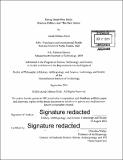| dc.contributor.advisor | Christine Walley. | en_US |
| dc.contributor.author | Edoh, Amah Melissa | en_US |
| dc.contributor.other | Massachusetts Institute of Technology. Program in Science, Technology and Society. | en_US |
| dc.coverage.spatial | f-tg--- fw----- e-ne--- | en_US |
| dc.date.accessioned | 2017-03-20T19:38:28Z | |
| dc.date.available | 2017-03-20T19:38:28Z | |
| dc.date.copyright | 2016 | en_US |
| dc.date.issued | 2016 | en_US |
| dc.identifier.uri | http://hdl.handle.net/1721.1/107527 | |
| dc.description | Thesis: Ph. D. in History, Anthropology, and Science, Technology and Society (HASTS), Massachusetts Institute of Technology, Program in Science, Technology and Society, 2016. | en_US |
| dc.description | Cataloged from PDF version of thesis. | en_US |
| dc.description | Includes bibliographical references (pages 217-225). | en_US |
| dc.description.abstract | This dissertation examines how Africa's place in the world is negotiated in different forms of material engagement with Dutch Wax cloth--designing, advertising, selling, buying, and tailoring-along the cloth's trajectory between the Netherlands and Togo. Derived from a manual Javanese textile printing technique, Dutch Wax cloth has been machine-printed in the Netherlands since the late 19th century, and was introduced to West Africa in the early 20th century. Lomé, Togo was a hub for its distribution throughout West and Central Africa for much of the 20th century. The cloth's visual and material attributes were historically developed through exchanges between West African consumers and European manufacturers and Dutch Wax has since been integrated into both dress practices and processes of social reproduction in Togo, as in much of West Africa. Further, in recent years, the cloth's producer has been rebranding itself from a textile manufacturer for Africa into a global luxury design and fashion brand. As such, Dutch Wax cloth has and continues to not only mediate but also embody West African participation in the global. By examining how Dutch Wax is "done" in various sites of practice along its path-how it is given form, and what is produced alongside these forms-this multi-sited ethnography brings to light how Africa's relationship to and place in the global is negotiated in the practices of designers, advertisers, sellers, buyers, and tailors across the Netherlands, Togo, and "the global." I argue that the view of Africa-in-the-world (Ferguson 2006) that emerges in each of these sites of practice and across all five is one that is characterized by a tenuous play between absence and presence, visibility and invisibility, inclusion and exclusion. Even as it offers a seductive alternative to past discourses about a "hopeless," "crisis-ridden," "old Africa," the "New Africa" remains decidedly layered and multiple. | en_US |
| dc.description.statementofresponsibility | by Amah Melissa Edoh. | en_US |
| dc.format.extent | 225 pages | en_US |
| dc.language.iso | eng | en_US |
| dc.publisher | Massachusetts Institute of Technology | en_US |
| dc.rights | MIT theses are protected by copyright. They may be viewed, downloaded, or printed from this source but further reproduction or distribution in any format is prohibited without written permission. | en_US |
| dc.rights.uri | http://dspace.mit.edu/handle/1721.1/7582 | en_US |
| dc.subject | Program in Science, Technology and Society. | en_US |
| dc.title | Doing Dutch Wax cloth : practice, politics, and 'the new Africa' | en_US |
| dc.type | Thesis | en_US |
| dc.description.degree | Ph. D. in History, Anthropology, and Science, Technology and Society (HASTS) | en_US |
| dc.contributor.department | Massachusetts Institute of Technology. Program in Science, Technology and Society | |
| dc.identifier.oclc | 974488271 | en_US |
